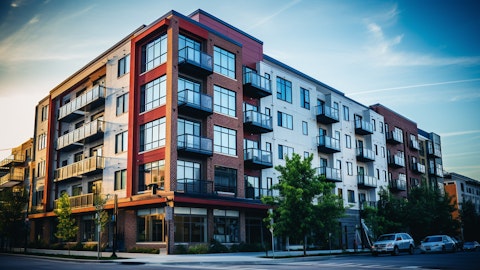And right now, we do expect renewal performance to be fairly stable, but we have modeled for further deceleration, like, later in the year. So, the full year is expected to come in just over 4%, which is still a pretty solid growth, but we do expect to see some deceleration. And I think when you look at the spreads right now that you see in the markets with new lease change or market pricing and renewals. Sure, there’s more stickiness when it comes to the renewals, and we have a lot of great rich history and data going all the way back to, like, 2006. That shows us that even when markets are dislocating, and I could use a San Francisco back in, like, 2016 where it was just getting a lot of new supply right on top of us. That market held up pretty well from the renewal standpoint and landed somewhere in that back half of the year with about 2% averages.
So, it’s not uncommon to see these spreads in the marketplaces. And the other thing, I guess, I would point out is we start getting into ‘24, our concession use was elevated back in ‘23. So, I can renew a lot of these residents flat in some of these expansion markets or Seattle and San Francisco and still walk away with a 6%, 8% increase on renewal. So, it kind of takes away some of the spread that you’re looking at and why we have so much but in that renewal number being right around 4%.
Alexander Goldfarb: Okay. The second question sort of dovetails on the rent fatigue comments. It seems, I mean, using New York as an example, no new supply, people want to be back in the city, and we don’t really hear stories anymore about doubling up or even moving to New Jersey is still an expensive proposition. So, from a pricing perspective, do you feel more comfortable today sort of across your portfolio, especially in markets like New York, in pushing pricing versus years ago when renters and I’m not just talking about new supply, but we’re doubling up or maybe moving to New Jersey or outer boroughs or something was more of an option. Do you feel like you have more pricing power today to push rents more than historically?
Michael L. Manelis: Yes. Alex, this is Michael. I’ll start. Maybe somebody can layer on top of that. I think this is really a market and submarket kind of look. So, it really just depends as what is the spread, how much is Brooklyn’s rent compared to Manhattan, what is that trade-off, decision to happen. So, I don’t know that I’d say I have more pricing power today than I have had historically. I would say we have really good processes in place today that help us navigate through these situations. And each market is going to deliver different rate growth based on a whole lot of factors that go into the strengths of markets. And as we look for, 2024, all I can say is that the setup feels pretty good. Yes, it’s like normal. The rents are doing what they seasonally should be doing, sequentially building each week.
Our application volume is sequentially building each week. I think we need to see that momentum in that early part of the spring leasing season to really be able to answer that question and tell you, do I feel like I got more pricing power or less than historical times.
Alexander Goldfarb: Thank you.
Operator: And our next question is going to come from Rich Anderson from Wedbush. Please go ahead.
Rich Anderson: Hi, thanks. Good morning, everyone. So, on the topic of expansion markets, is it absolutely a fee simple type of investment? Or would you be open, given the sort of the complexity of all the lending environment and all that sort of stuff and some and distress balance sheet distress and whatnot. Would you be willing to invest, in different areas of the capital stack and with an intention to ultimately own? Or are you going to have enough opportunity to keep it simple and just go, through equity channels.
Alexander Brackenridge: Hi, Rich. It’s Alec. Well, we prefer simple if it’s available, but if there’s a good opportunity that would require us to participate elsewhere in the capital stack that would lead to us likely owning the property, we’re wide open for that as well. So, I do think there’s going to be a lot of fee simple stuff out there, though. So, we’ll balance that out, but we’re happy to talk to anyone that owns a while located apartment in the expansion markets, about any structures they have.
Rich Anderson: Okay. Great. And then, if I could just sort of, ask the sort of a different question about, what you said, Mark, earlier about 2025 being a tougher year in the Sunbelt versus 2024. But then you said something like, but the second derivative might be thought to be better. I didn’t quite understand that. So, maybe you can clarify that. But would you say, generally speaking that the Sunbelt sort of recovery process is maybe a year behind San Francisco and Seattle? Is that, like, does that sort of help define the condition that you see it today?
Mark J. Parrell: Yes. Well, I’m going to say is just how we’ve seen things play out in our market. So, the first thing that you see is you start to see a decline in occupancy when you get all of this, when you get a lot supply or big demand drop or both. So, the markets you’ve seen competitors in the RealPage numbers sort of show declines in occupancy. That pressures owners to give concessions and lower face rate, and then that in turn eventually affects same store revenue, which is, of course, the interplay between occupancy rate, renewals, and the whole nine yards. And so, in when it reverses, the exact opposite happens. First, you start to see, I’m building my occupancy a little. As Michael spoke to Seattle and San Francisco, that gives you a little bit of confidence.
So, now you’re going to take away of your concessions, you’re going to try to move rate up a little, especially in the spring leasing season, you’re going to test that as that improves, and, eventually, that’ll flow through to your same store revenue number. So, that’s what I mean by that comment. So that this year, same store revenue might hold up better in a heavily supplied market or a demand challenged market because you’re looking at a situation where your rents, you haven’t rewritten every lease down yet.
Rich Anderson: Right.
Mark J. Parrell: But over the course of two years, you will. And in that process, that second year same store revenue number is often lower, But we’re often telling you, hey, you know what? New lease is going up. We’re feeling better in a market. And that’s what I’m sort of expecting. We’ll see how it goes, but my expectation is sometime in ‘25, folks will be talking about an improvement in some of those, I call it second derivative, but new lease rates, street rent numbers, and it isn’t going to be dramatic right away, but it’s sort of some solidification of that that’s really built on occupancy starting to improve. So, again, you got all this supply. Our experience is it compounds. It gets worse before it gets better, and it just takes a little while to run through the entire P&L. Is that helpful, Rich?
Rich Anderson: Yes. That’s really helpful. Thanks. And then would you then sort of characterized Sunbelt as being X money months behind San Francisco, Seattle? Is it a year in your mind if you were to just sort of simplify it?
Mark J. Parrell: I don’t have a prediction on that. We told you we didn’t put San Francisco and Seattle in this year’s improvement bucket. I have high hopes, but it feels like because of supply in Seattle and just job conditions in San Francisco, it could take a little longer, and I think the Sunbelt is just starting its challenges. So, I think both areas will be a little challenged in ‘24.




